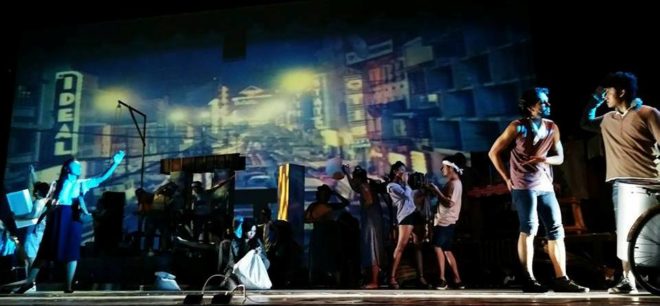
Gantimpala Theater Foundation and Grand Leisure Corporation’s production of “Maynila sa Mga Kuko ng Liwanag,” which ended its run recently at Kia Theater, Quezon City, was a valiant, earnest attempt to musicalize a classic work of Philippine cinema and literature.
The Edgardo Reyes novel, and Lino Brocka’s film adaptation, had explored in the 1970s the subjects of urban poverty, exploitation and social injustice—how life in the capital suffocates and oppresses the masses.
Schizoid storytelling
The material is clearly a tragedy, a social-realist document. The musical, however, was an unfortunate case of baffling schizoid storytelling: that story of grit and smallness blown up by music and movement into a show that suggested drama on an epic scale. Every dance number, song and piece of acting in this production directed by stage stalwart Joel Lamangan, along with a lack of character development and plot holes left awkwardly unresolved, ended up undermining the bleakness and intimacy of the source work.
The score—libretto by Jose Victor Torres and Em Mendez, soaring music by Von de Guzman—brought one show-stopping, frenetically choreographed number after another. But how to square that with the plainspoken story of country boy Julio (an affecting, beautiful-voiced Arman Ferrer) leaving his hometown to find his sweetheart Ligaya (Lara Maigue alternating with Sheila Valderrama-Martinez) in the harsh underbelly of Manila, a harrowing quest that would lead to tragedy?
Heart and gusto
Reviews of Brocka’s film uniformly hailed the director for making Manila the main character in the movie—a throbbing, living entity that was both attractive and horrific, full of dreams yet deadly to those it lured into its bosom.
The musical “Maynila” achieved roughly the same effect in its first few numbers, and in several isolated scenes afterward. The score took the audience from one scene to the other—construction site to slums to a mysterious house in Binondo—with riveting song and dance. It was like every sector in the city had its own signature production number, and the ensemble, buoyed by Douglas Nierras’ stunning choreography, delivered with heart and gusto.
De Guzman’s music, gorgeously melodic in many moments, was this “Maynila’s” main strength—and also its main weakness. At three hours and 15 minutes long, the highlight-heavy show eventually felt more like one huge concert. One could deduce the narrative simply by closing one’s eyes and listening to the music; some of the numbers also appeared to be there merely to plug immense gaps in characterization and plot structure.
The death of Julio’s friend Atong (Noel Rayos) inside a jail, for instance, led to a stirring Act 1 closing number that cried out for justice for the city’s oppressed workers. But this newfound sense of militancy and incipient revolution was a development that went nowhere. Similarly, Pol (Floyd Tena) and Perla (Rita Daniella alternating with Aicelle Santos) would mourn, in two extended duets, for a supposed lost love between them that was never established.
Fatal dilution
Most fatally, while the negotiations between the Chinese man holding Ligaya and the pimp Mrs. Cruz (Dulce alternating with Ima Castro) were an entertaining and humorous romp, the moment altogether diluted the menace and power the man represented. So, when the trapped Ligaya revealed to Julio her husband’s murderous threats, they simply did not ring true.
Julio and Ligaya’s tragic fates were faithful to the material, and Lamangan’s depiction made it plain how the city can be unforgiving to its rebels. But a tacked-on ending—the two lovers finally reunited in a heaven-like, all-white space—came out of context, and was a forced and unnatural punctuation to the story.
“Maynila sa Mga Kuko ng Liwanag, The Musical” had lofty ambitions that essentially ran counter to the spareness and simplicity of its source story. With the musical numbers dominating the narrative and calling attention to themselves, the doomed story of Julio and Ligaya struggled to hold center ground. Perhaps a rerun could occasion the needed fixes? —CONTRIBUTED